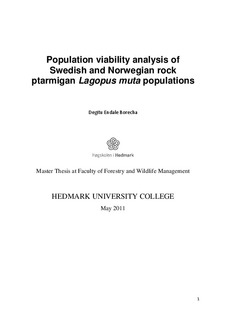| dc.contributor.author | Borecha, Degitu Endale | |
| dc.date.accessioned | 2011-11-14T09:30:03Z | |
| dc.date.available | 2011-11-14T09:30:03Z | |
| dc.date.issued | 2011 | |
| dc.identifier.uri | http://hdl.handle.net/11250/132229 | |
| dc.description | Masteroppgave i anvendt økologi. Evenstad, 2011 | no_NO |
| dc.description.abstract | Population viability analysis (PVA) is a method of projecting the likely future state of a population or populations of a species using quantitative methods. It is principally used to determine the population(s) risk of extinction, decline, or recovery for a given period in the future based on the current demographic and environmental data of the population(s). I conducted PVA single and metapopulation models for both the Swedish and Norwegian rock ptarmigan populations by using transect count data and wing data, respectively. My objectives were to determine; (1) persistence probability of the populations in the future given current population development; (2) relative quasi-extinction risk of the populations; and (3) demographic parameters that have major impact on the population´s long term viability. My model showed that the Swedish populations are doing better than the Norwegian populations in terms of persistence probability. The hypothetical metapopulation models represented a smaller risk of quasi-extinction than the single population models. Using single population model, the rock ptarmigan population in the county of Västerbotten in Sweden showed high extinction risk. The most sensitive parameters in my models were the growth rate and environmental variation. Even though the results from my PVA models are associated with several uncertainties, I strongly recommend that the populations are in need of more attention than what they receive today. | no_NO |
| dc.language.iso | eng | no_NO |
| dc.subject | grouse | no_NO |
| dc.subject | Scandinavian rock ptarmigan | no_NO |
| dc.subject | rype | no_NO |
| dc.subject | Population viability analysis | no_NO |
| dc.subject | PVA | no_NO |
| dc.title | Population viability analysis of Swedish and Norwegian rock ptarmigan Lagopus muta populations | no_NO |
| dc.type | Master thesis | no_NO |
| dc.subject.nsi | VDP::Mathematics and natural science: 400::Zoology and botany: 480 | no_NO |
| dc.source.pagenumber | 33 s. | no_NO |
